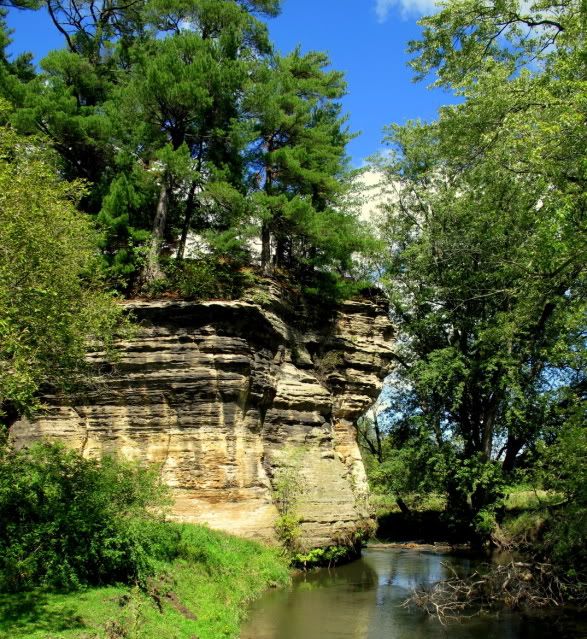
17 trout to hand..biggest around 14 inches.

17 trout to hand..biggest around 14 inches.

Question Mark Butterfly With A Fishing Spider Attempting To Dine On It

Great Spangled Fritillary Butterfly On A Bull Thistle

Yellow Tiger Swallow Tail Butterfly On Purple Asters

A Blue Tiger Swallow Tail Butterfly

My wife and daughter watch lots of Ghost Stories on television. They had a "girls" outing yesterday to three of the allegedly haunted places in Wisconsin. Their first stop was in Green Lake Wisconsin.
http://www.ghosthaunts.com/wis…ed-dartford-cemetery.html
They had no EMF monitors or any of the other NONSENSICAL equipment that you see on the BOOB Tube.
They were in search of DARTFORD Cemetery.

The cemetery was easy to find.
Anna and Barb had to look around for quite a while to find "the crypt" from the TV show.

Legend has it if you sit on the crypt that the spirits will push you off the top.
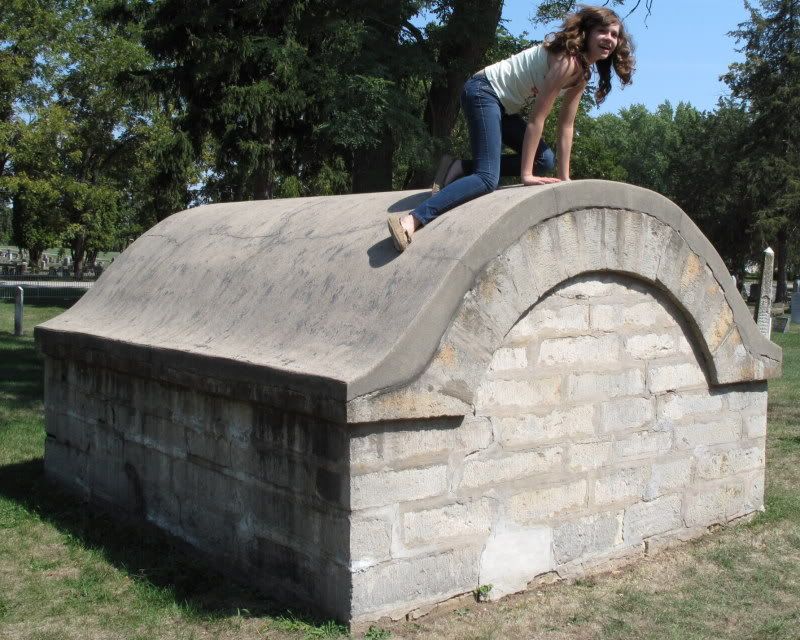
With no pushing or anything the girls moved on to their second target.

The Ramada in Fond du lac was their second target
http://suite101.com/article/ha…aza-hotels-ghosts-a199148
There were weddings on every floor and girls left quickly without any to report.

They had some time to kill so Anna had her palm read. Their appointment at the Octagon House was not until 3pm.
http://www.hauntedhouses.com/states/wi/octagon_house.htm

The House was run by a wonderful old lady that was very nice and treated the girls very well. The place had once been part of the "Underground Railroad" from the Civil War days.

A wrap of the days events was:
"No spirits or paranormal events to report"
I am really glad I didn't go.
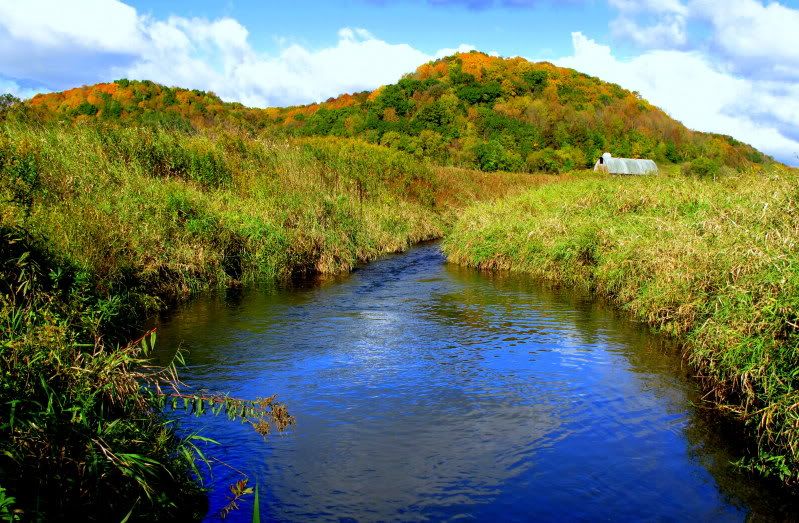
The last day of season I saw the biggest trout I have ever seen in my life in this hole. It will be there again in September
The first cold snap always makes me smile. The change of weather turns the woods to a tapestry of
amazing colors. That same cold snap that changes the colors of the leaves also turns on an instinct in the trout. The urge to reproduce is in full gear.
Most times the trout get going a little early. This urge typically causes them to swim upstream. The smaller head waters are where they are in search of. The breeding process doesn't actually start until late October or early November. This doesn't stop the wayward trout. Their wander lust has already been turned on and they are on a mission.
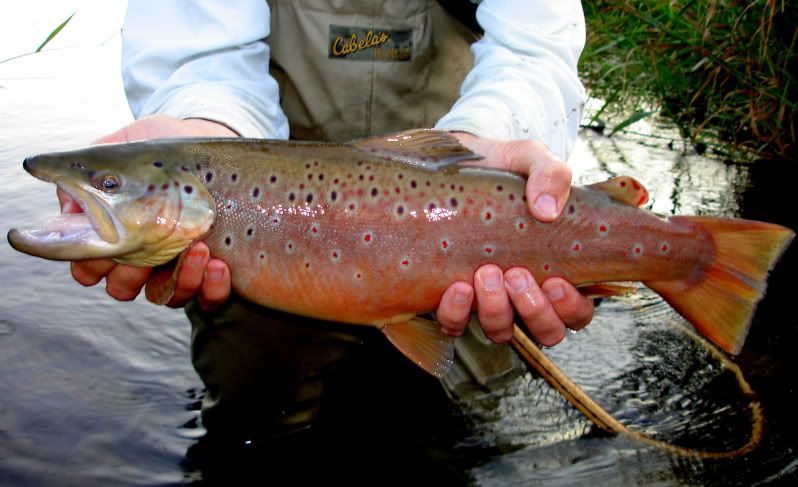
Male trout are the colorful ones of the trout world. This male brown is all decked out in his courting apparel.
Big trout that typically live in a large stream head up the small tributaries. They can swim a mile in a day easily. These fish are out of their typical lays and deeper holes. They are driven to the smaller water. The head waters are where the bottom make up perfect for laying eggs. The smaller pea sized pebbles are what they are in search of. The head waters also are better for the temperature range they require. The females lay their eggs in small depressions in the pebbles and the males fertilize the eggs and their business is done.
During this time they are opportunistic eaters. This is the time of the year you may catch a 25 inch trout in 14 inches of water. They already are getting their Fall colors and eating is secondary after the mating itch. Some male trout can look almost tropical because of their bright colors at this time of the year.
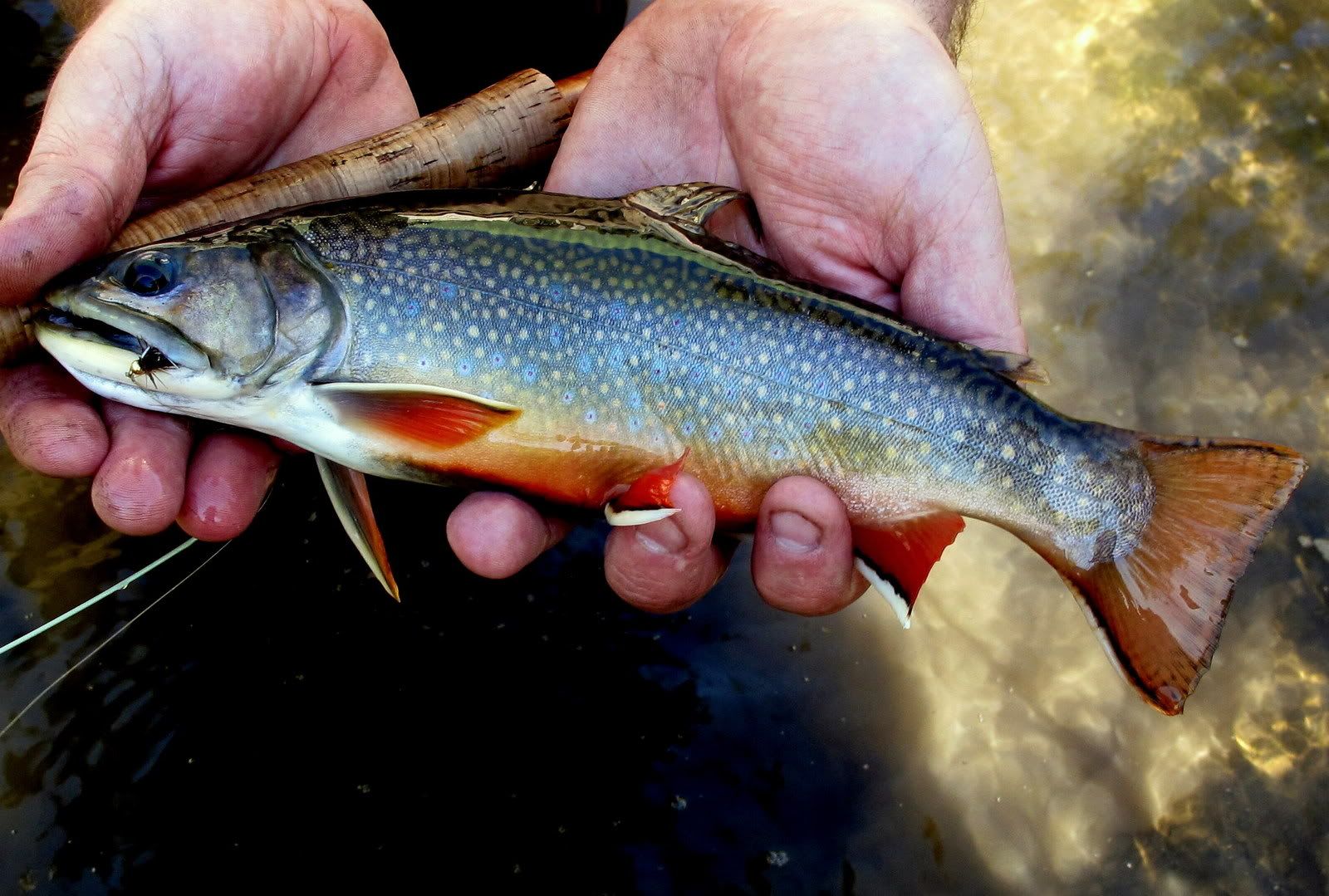
This male brookie has his finest tuxedo on to attract the females to him in the Fall already.
These times are called BIG trout times. Don't just target the deeper water. Fish every run and every weeded shallow stream bank. The bigguns will be in spots they are not typically. Get out there after the first cold snap and catch a monster.
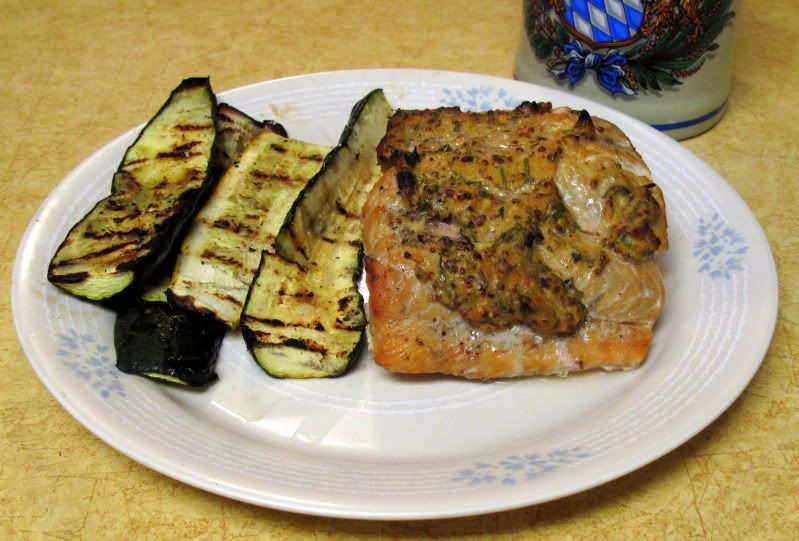
Ingredients
2 garlic cloves
3/4 teaspoon finely chopped fresh rosemary leaves
3/4 teaspoon finely chopped fresh thyme leaves
1 tablespoon dry white wine
1 tablespoon extra-virgin olive oil
2 tablespoons Dijon mustard
2 tablespoons whole-grain mustard
Nonstick olive oil cooking spray
6 (6 to 8-ounce) salmon fillets
Salt and freshly ground black pepper
Served with grilled Zucchini and Yellow Squash
Thanks for the Fresh Salmon Mike.
Anglers in Wisconsin should know their poisonous snakes before they go out in the field. The two venomous snakes that live in Wisconsin are both rattle snakes. They are the Massasauga Rattle Snake and the Timber Rattle Snake. Both are endangered species and very misunderstood. They will not confront you and will attempt to escape when cornered. The other snakes in this article are snakes that resemble poisonous snakes you may encounter. They are dangerous to the angler and to uncontrolled pets. I recommend seeking immediate medical attention for you or your pet when bitten.
The Massasauga "not pictured here" is the smaller of the two and grows to about 20-30 inches in adulthood. The Massasauga has brown back markings and triple rows of brownish-black side patches . The body markings are edged in black. The tail has five to seven dark rings and a grayish rattle. They live in river bottom forests and nearby fields. Massasaugas also like prairies and lowlands. They eat frogs and other small snakes and sometimes dine on rodents.
The Timber Rattler is typically 36-56 inches as an adult. It has a solid gold colored head . Its body is marked with black or dark brown cross bars. The tail is black and the rattle is typically tan in color. These snakes live in the bluffs of western and southwestern Wisconsin. In the summer they move to the forests. They are prolific rodent eaters. They will move back to the bluffs to winter. 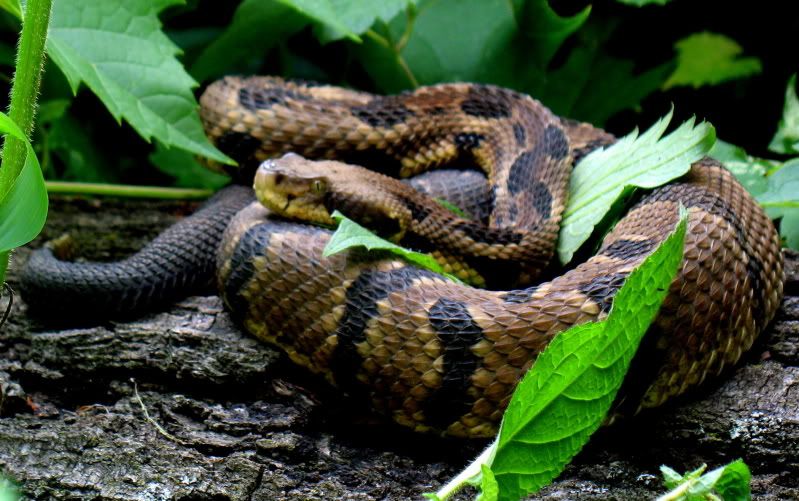
Photo by: Scott Hale
This Timber Rattler was hiding in the weeds. You will never forget your first sighting of a rattle snake.
Another local resident is the Northern Water Snake. It gets 24-40 inches long. It is a very common snake in Wisconsin. It lives near permanent lakes and rivers and loves to eat frogs, crayfish and smaller fish, both dead and alive. It has grayish brown patterns on its body. This snake is often mistaken for a Water Moccasin and incurs the wrath of many anglers. Water Moccasins are not residents of Wisconsin.
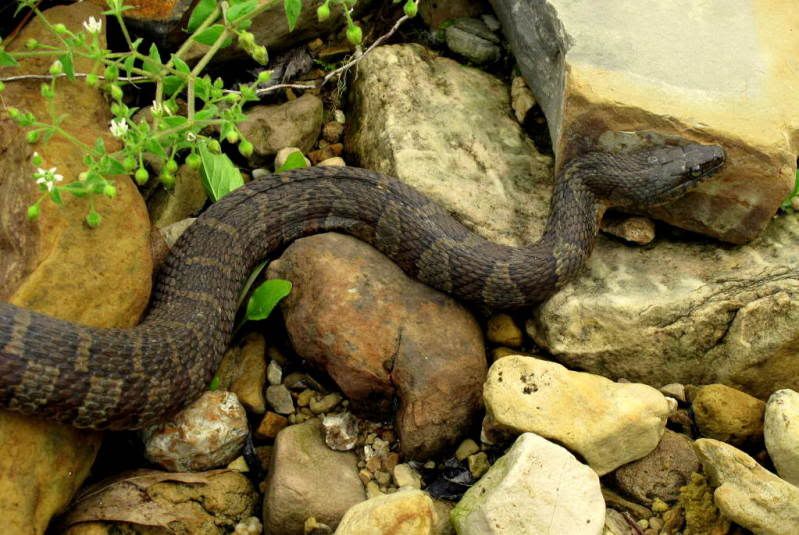
Photo by: Len Harris
The northern water snake is very common in Wisconsin. They are often mistaken for water moccasins and killed.
The Bull Snake is the largest of all Wisconsin snakes. It reaches 50 to 80 inches at adulthood. It has a bad reputation because of its nasty demeanor. It also resembles a rattle snake and receives the fear and disdain that comes with the possibility of being poisonous. Bull snakes are endangered and illegal to kill. Their heads have the classic diamond shaped pattern. Bull snakes have heavily patterned heads and a pointed tail with no rattle. They are good for rodent control.

Photo by: Len Harris
The bull snake is the biggest snake a Wisconsin angler might run in to while fishing. They are very testy and are often mistaken for rattle snakes.
The Gopher Snake is a sub species of the Bull Snake. They are also an endangered species. They too are often mistaken for rattle snakes. They are much smaller than their cousin the bull snake. They have pointed tails and no rattles. They only grow up to 40 inches as an adult. Their demeanor is much more laid back than their much larger cousins. The best way to identify them is the mask across their eyes. They are prolific rodent eaters and hence their name, the Gopher Snake.

Photo by: Len Harris
This gopher snake posed for me on the edge of the road. I took a few photos and left it alone. Learn your snake species in your fishing area.
Snakes in the wild should be given a wide berth. They typically will crawl away from you way before you are even close enough to see them. Your pets are in particular danger and need to be controlled around snakes. Many people only see a snake when it is dead alongside of the road. Venomous snakes can still transfer their venom after death so don't play with them. I know I am sounding like a broken record but if you think your pet or yourself have been bitten please seek immediate medical attention.
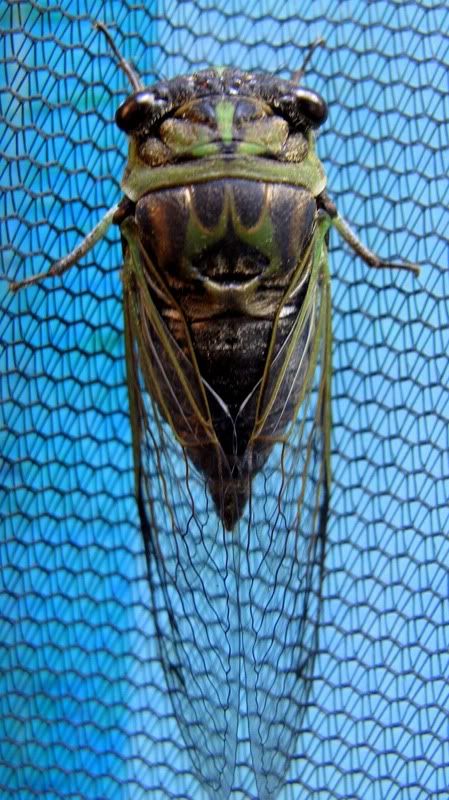
Found this perched on my tent this morning. Love to identify insect visitors.
Tibicen cicadas are 1-2 inches long, with characteristic green, brown, and black markings on the top of the thorax, and tented, membranous wings extending past the abdomen. The fore pair are about twice the length of the hind pair. Males produce loud calls in the afternoon or evening (depending on the species) to attract females. These sounds, distinctive for each species, are produced by organs below the abdomen's base. These calls range from a loud buzz to a long rattling sound. Adults feed using their beak to tap into the xylem of plants. Nymphs feed from the xylem of roots.
Many animals feed on cicadas, which usually occurs during the final days when they become easy prey near the ground. One of the more notable predators is the cicada killer. This is a large wasp that catches the dog day cicada. After catching and stinging the insect to paralyze it, the cicada killer carries it back to its hole and drags it underground to a chamber where it lays its eggs in the paralyzed cicada. When the eggs hatch, the wasp larvae feed on the paralyzed, but still living, cicada.
~Wikipedia

She turns 16 on the 22nd

Thank goodness she looks more like her mom than me.
Anna Harris
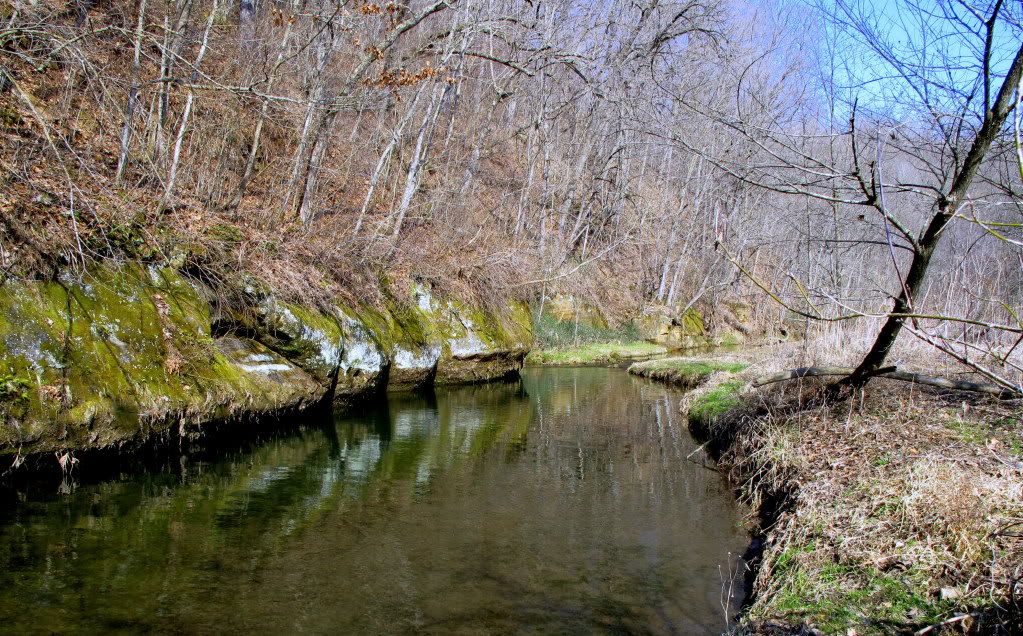
This hidden little valley could be a perfect place for a family to sink in roots in the early 1840s. I can see the Hinkst Family Homestead. It is at the head of the boxed valley. The rock walls block out the bitter northwest winds in the frigid Wisconsin winters.
There is a beautiful trout stream running through it. The stream's headwaters is only 150 yards from the building site. The stream will not freeze over in winter. There are pools deep enough to bathe and swim in. This stream would supply clean water and food for a budding family.
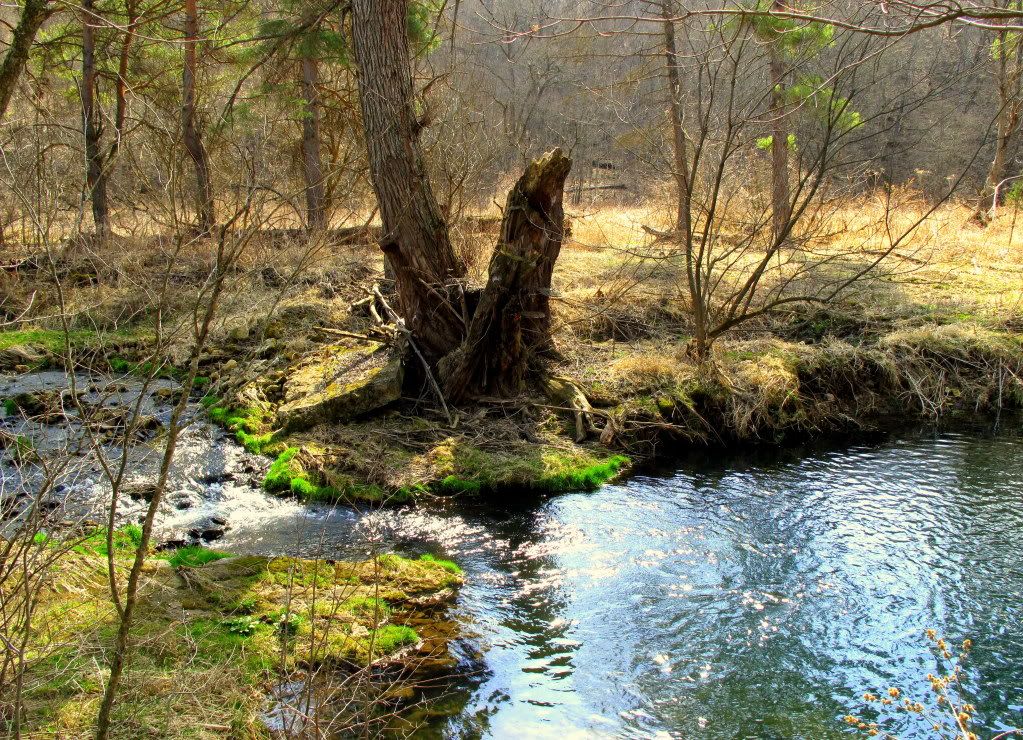
The building site needs to be up tight to one of the rock faces. It needs to be far enough away from the stream to not get flooded each spring. A house with a large open hearth needs to be built. The hearth is for cooking the abundant fish and game in the area and a heat source for the family during the long harsh Wisconsin winters.
The family builds the rock work first before they put up the home. Each person in the family has a hand in building the fireplace and ensuring their dream of living in the wilds of Wisconsin comes to fruition. The opening to the fireplace must be large. It needs to be able to handle the great black pot that was brought with them from out east. The pot will hang in the hearth and feed the family for generations.
The first winter was hard. The stream supplied water and fish. The snow was too deep to hunt far away from home. Fish was the main course for almost all dinners that first winter. Another way of cooking or preserving food was needed for that next winter. The family sat around the fire and brainstormed. The solution was right there before their eyes. There were extra bricks left from building the fire place.
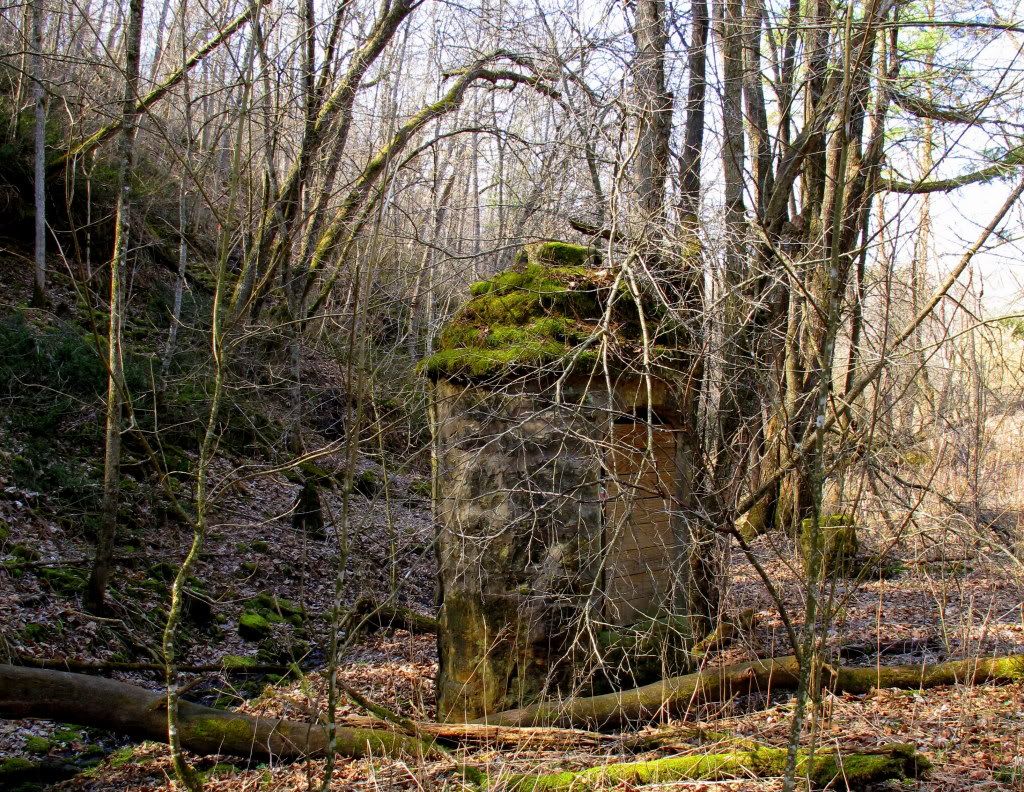
The work on the smoke house began the next morning. It needed to be big enough to smoke an entire deer. It needed to be a permanent building that would hold up for years. The roof of the smokehouse needed a vent to let the smoke escape. This was the hard part. A building that could handle fire and smoke and not burn down. After a couple failed attempts the smoke house was completed. Smoked food kept for much longer and it would give them another meal during the winter other than fish.
The homestead looks this way these days. The home either burnt down or time tore it down. The smoke house still stands on the edge of the property and to this day looks like it could smoke some tasty game. There is a heavy layer of moss on the roof of the smoke house but it still looks functional.
The fireplace still remains. The place to hang the big black pot is out of place dangling above the open hearth. The memories of the family still exist and you don't even need to use your imagination that much to visualize it. . ..... The stream is the only thing that remains constant and unchanged.
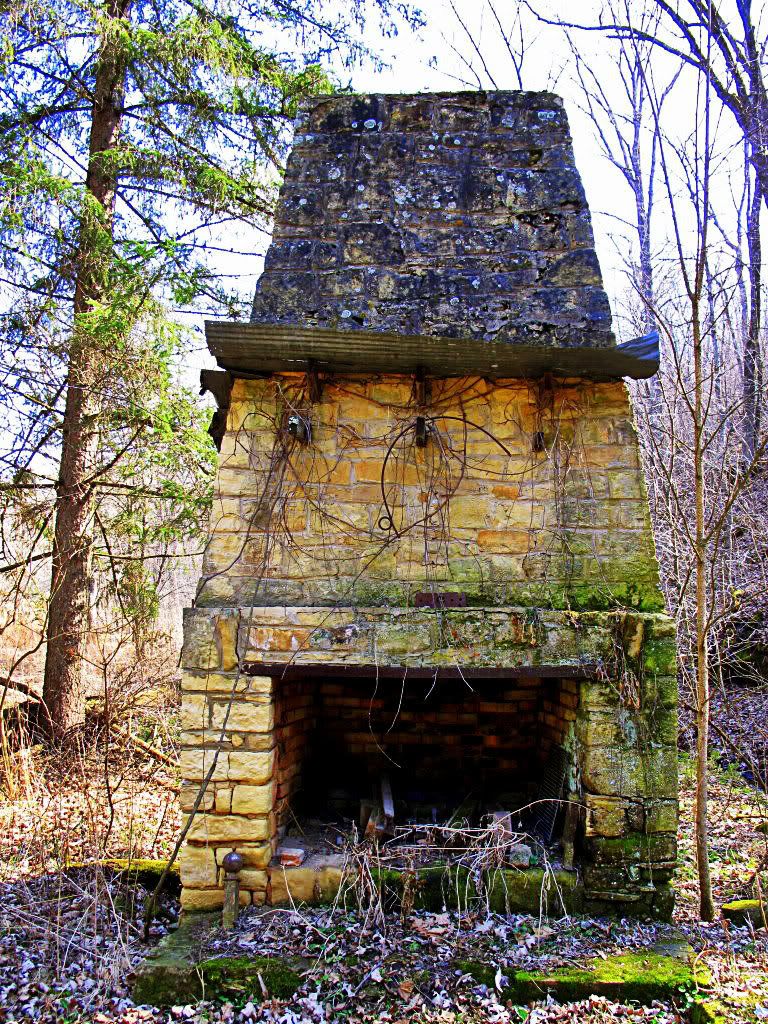
I would like to buy one.
I don't want to spend an arm and a leg please.
If you have one for sale please send a photo and your price to my email address?
Thanks
I got up nice and early today. There was not a cloud in the sky so I decided to get out and try for some browns before the sun and our impending hot weather in the next week could hit.
I geared up and off I went to the Pine River looking for a full morning of catching nice browns.
I have a silly superstition that I learned from my father.
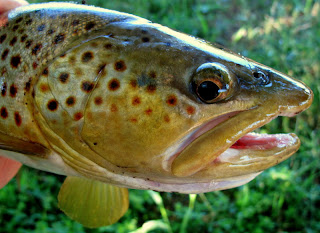
If you catch/lose a twenty inch brown you are to stop. The outing is over. I have held true to this superstition since I was 5 years old.
Today was not the day to quit being superstitious.
The second cast of the day was my last cast of the day.
Planning on another outing tomorrow morning..
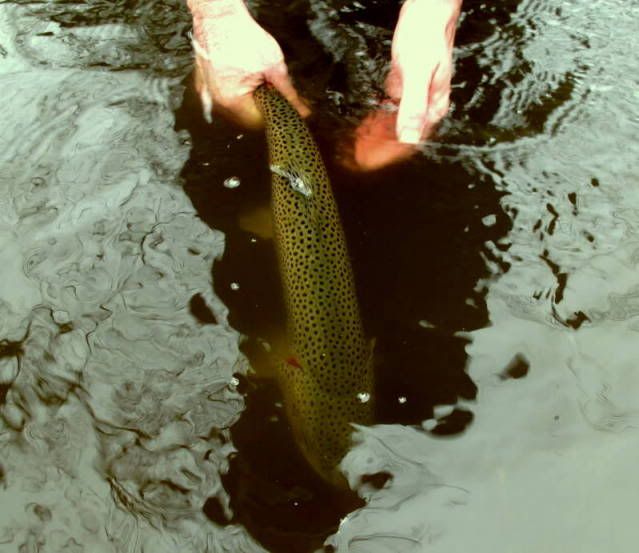
These dog dayz are the absolute best time of the year to catch a XXL Trout.
The water temps are soaring and big dogz look for thermals to nose up to.
They are the biggest trout and will demand the best lays right near the springs
feeding in. The only negative of fishing this time of the year besides obvious
hot conditions is the trout are much easier to over tire and if you fight them
too long they will die after release. Hot water retains less oxygen and after
a prolonged battle trout build up lots of lactic acid and they need oxygen
rich water to recharge their batteries. With the warm water there is less oxygen
to recharge those batteries.

Scott LaRochelle Flew In From Virginia

Scott a good buddy from Wisconsin moved out East last year following his fiance "Carol" out east. Scott attempted to get a teaching position out their but they were slim pickings. Scott is currently employed by an Orvis shop where he lives.
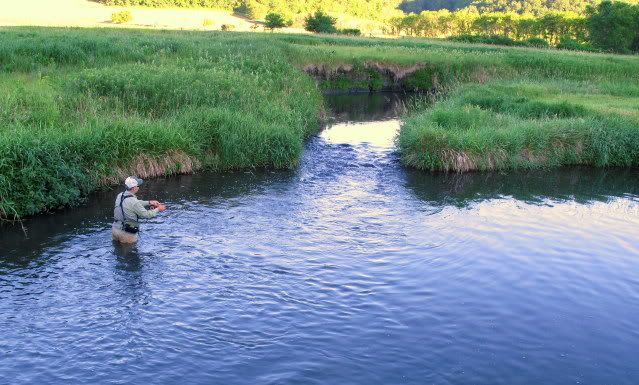
We hit the water at 6:15am. Scott scored a brook/brown/bow trifecta. He landed approximately 25 trout and I landed 15. Scott caught trout of the day around 16 inches. Buggers were his choice today in size 8 and 10.
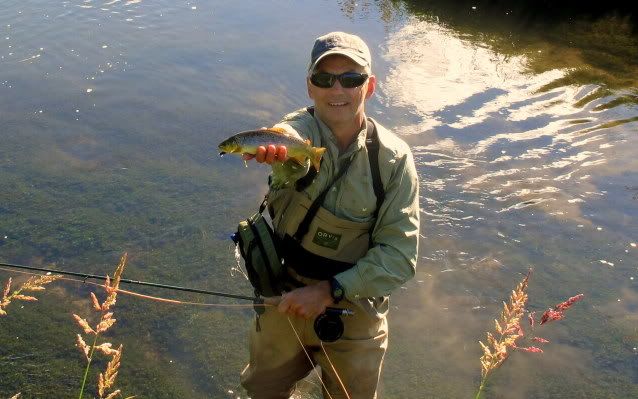
I discovered a red winged black bird nest with a couple eggs in it. The mother bird gave it up at the last second as I walked by. I thought it was already past time to have baby birds. Maybe they decided to have a second batch
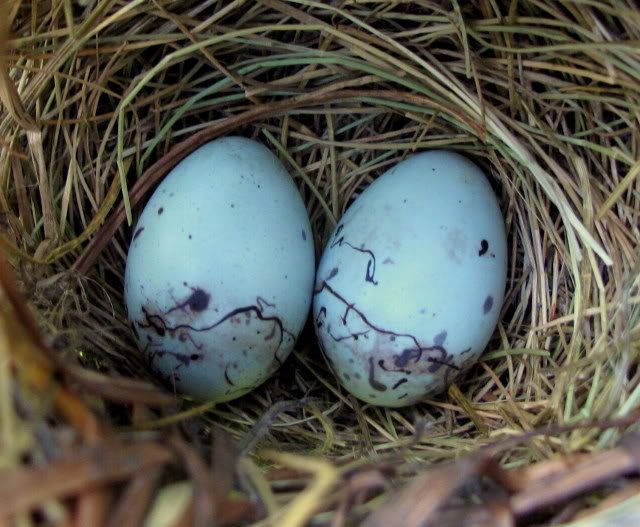
We ended the day locally. It was pretty obvious the stocking trout had dropped off brooder rainbows. We had no hook ups but we saw a pod of 50 trout and there were 20 bows in there over 20 inches and a couple were pushing 25 inches.
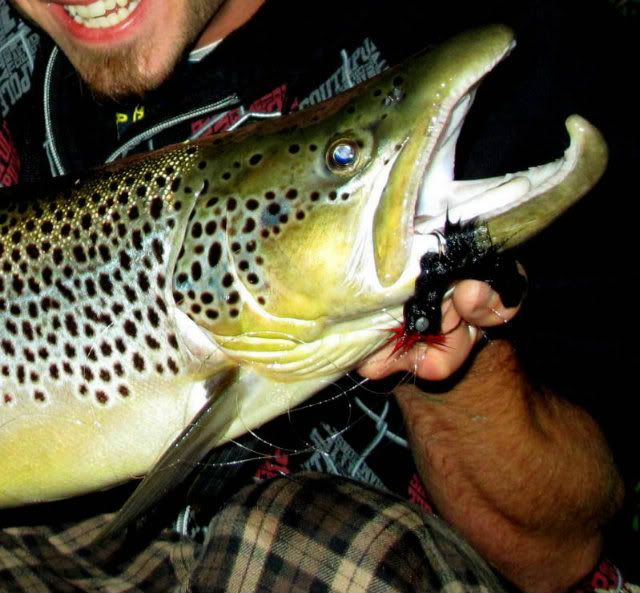
Another absolute monster caught at night on a dumbell eyes bunny leech.
Night Time Is The Right Time!!!!
Ted has been busy with his band's 9th album. It will be done soon.
He has his boat in the driveway and has prepped it. All he needs now
is to have Tourniquet's album completed and he is ready for salmon.
He took me out last year.
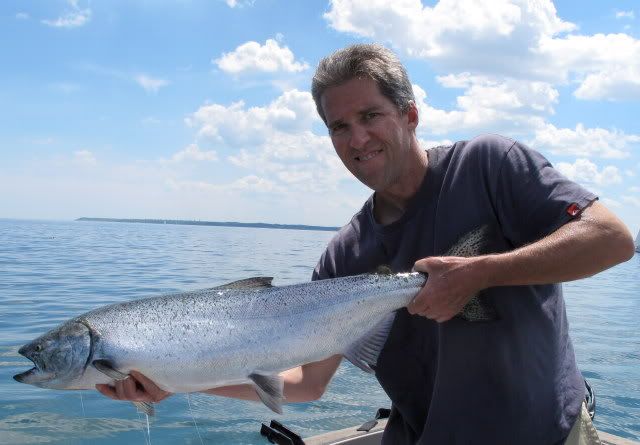

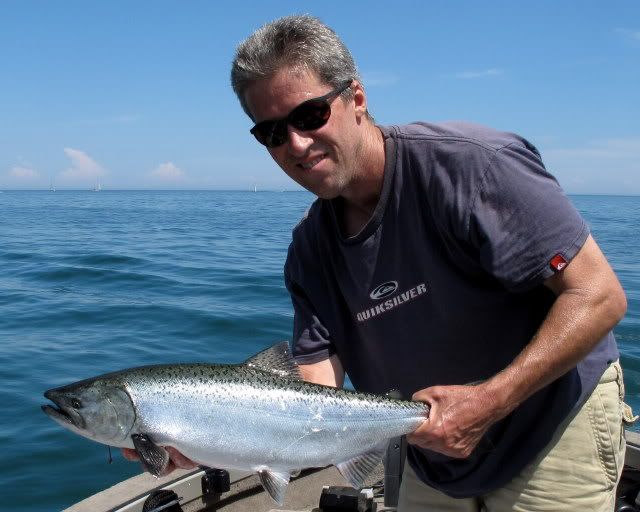
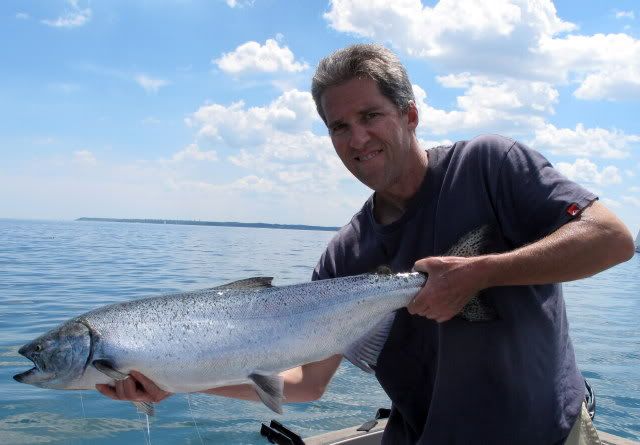
I am more than ready.
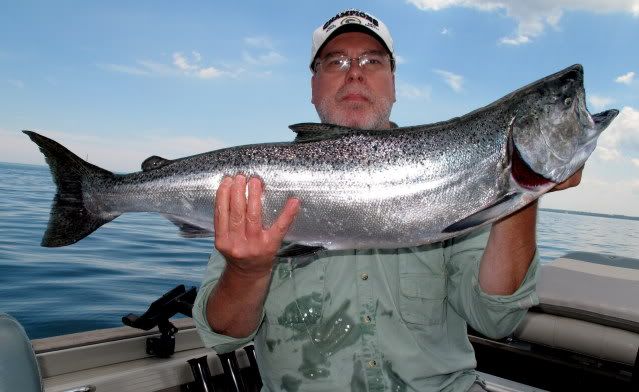
I have my new fenwick rod all ready and some 30 pound power pro on my shimano reel.

